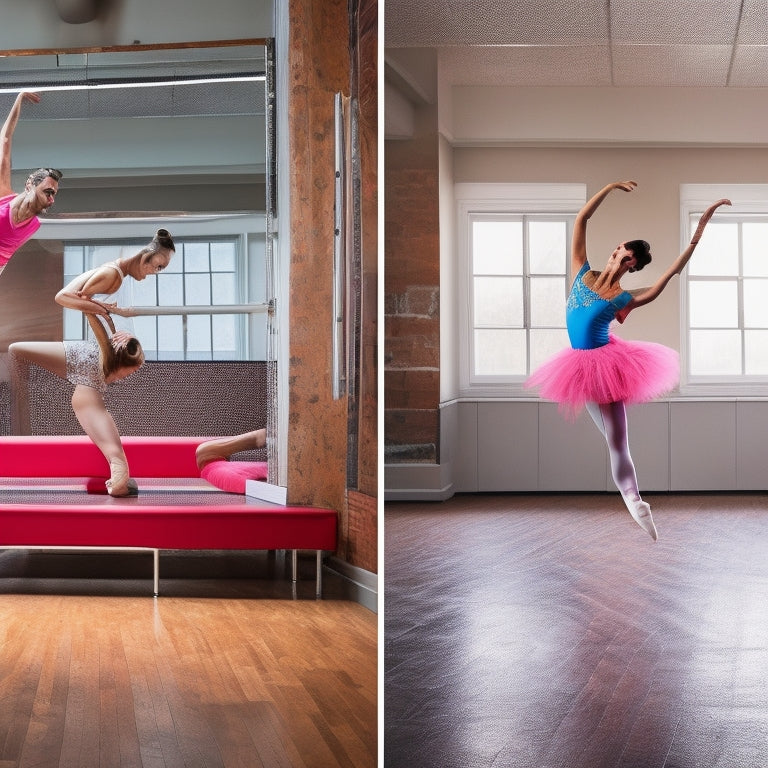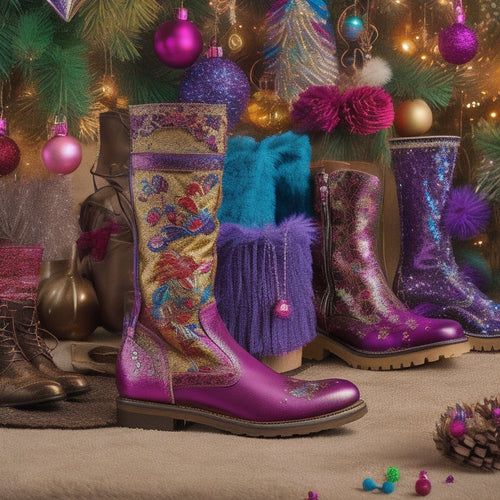
Can You Wear Converse to Dance Class?
Share
When selecting Converse for dance class, it is crucial to take into account the type of dance style, your personal comfort level, and the level of support and stability you need to perform at your best. Converse offers rugged outsoles, breathable materials, and flexibility, making them suitable for certain dance styles like hip hop, jazz, and breakdancing. However, they may not provide enough arch support or cushioning for other styles. As you evaluate the pros and cons, keep in mind that your dance performance and foot health depend on finding the right footwear for your needs - and there's more to explore to find your perfect fit.
Key Takeaways
• Converse can be suitable for dance classes that prioritize flexibility and grip, such as hip hop, jazz, and breakdancing.
• However, Converse may not provide sufficient arch support and stability for dancers who need it, potentially leading to injuries.
• Dancers should consider their personal comfort level, dance style, and technique requirements when deciding whether to wear Converse.
• Converse may hinder performance in dance styles that require extensive ankle mobility, such as ballet or contemporary.
• It's essential to prioritize foot health and safety by choosing shoes that match the demands of your dance style and provide necessary support.
Converse Features for Dance Class
When choosing Converse for dance class, you'll appreciate the rugged outsoles that provide stability and traction, allowing you to pivot and turn with confidence.
As you move across the dance floor, you'll notice the breathable materials that keep your feet cool and dry, even during the most intense routines.
The flexible design of Converse shoes also allows for excellent ankle flexibility, giving you the freedom to move your feet in any direction without restriction.
This means you can focus on perfecting your technique, rather than worrying about your shoes holding you back.
With Converse, you can dance with confidence and style, knowing your shoes have got your back – or rather, your feet.
Support and Stability for Dancing
You'll need shoes that provide adequate arch support and stability to help you maintain proper alignment and prevent injuries while dancing. As you move across the dance floor, your shoes should provide the necessary support to keep your ankles stable. This is especially important for dancers, as ankle strength is vital for turns, jumps, and quick changes in direction.
Without proper support, you're more likely to roll an ankle or put unnecessary strain on your joints. Look for shoes with sturdy soles and breathable materials that will keep your feet cool and dry.
With the right support, you'll be able to focus on perfecting your technique and enjoying the dance class experience.
Impact on Foot Health
As you lace up your Converse for dance class, you're probably thinking about mastering those tricky steps, but don't forget about your foot health!
Wearing Converse can put your feet at risk, especially if you're not used to dancing in them.
It's crucial to take into account the lack of arch support and toe protection, which can lead to discomfort, pain, and even injuries if you're not careful.
Arch Support Matters
Converse shoes, with their lack of arch support, can lead to a multitude of foot problems, including plantar fasciitis and Achilles tendonitis, which can ultimately derail your dance progress. As you incorporate dance into your daily routine, it's essential to prioritize your foot health. Without proper arch support, you may find yourself struggling to reach your fitness goals.
Imagine being sidelined by an avoidable injury, forced to watch your classmates perfect their pirouettes while you're stuck on the sidelines. Don't let Converse shoes hold you back from achieving your full potential. Invest in shoes that support your arches, and your body will thank you. By making this simple switch, you'll be able to dance with confidence and ease, taking your skills to the next level.
Toe Protection Needed
When dancing in shoes that don't provide adequate toe protection, your toes are exposed to constant pressure and friction, which can lead to painful blisters, toe curling, and even toenail damage.
Without proper protection, your toes are vulnerable to injury, which can hinder your dance performance and overall experience. That's why it's crucial to prioritize adding toe caps or toe wraps to your dance gear. These simple accessories provide a barrier between your toes and the shoe, reducing friction and pressure.
Dancing Techniques and Converse
You'll find that certain dancing techniques require more ankle mobility than others, and wearing Converse can either hinder or enhance your performance depending on the style.
For instance, if you're taking a contemporary or modern dance class, you'll want to focus on flexibility exercises to improve your range of motion. In that case, Converse might restrict your movement.
On the other hand, if you're taking a hip-hop or breakdancing class, you'll need strong muscle control, and Converse can provide the support you need.
You'll need more ankle mobility for turns and leaps in contemporary or modern dance.
Converse can provide the stability you need for powerful movements in hip-hop or breakdancing.
Make sure to stretch and warm up properly to prevent injuries, regardless of the style you're dancing.
Alternative Dance Shoes Options
If Converse aren't your go-to dance shoes, explore alternative options that cater to your specific dance style and needs. You might find that sneaker innovations have led to amazing alternatives that provide better support, grip, or flexibility for your dance style.
For instance, dance fusion classes might require shoes that allow for smooth turns and quick movements, while hip-hop classes might need shoes with extra cushioning for high-impact landings. Look for shoes designed specifically for your dance style, and consider factors like breathability, traction, and ankle support.
With so many options available, you're bound to find the perfect shoe to help you shine on the dance floor. Don't be afraid to experiment and find what works best for you!
Comfort Vs. Performance Tradeoff
Five key factors influence the comfort vs. performance tradeoff in dance shoes: cushioning, flexibility, support, breathability, and traction. As you weigh these factors, consider your fashion priorities. Are you looking for a shoe that's perfect for everyday wear, or are you willing to sacrifice some comfort for better performance on the dance floor? You'll need to find a balance that works for you.
Here are a few things to keep in mind:
- A shoe with good cushioning will absorb shock, reducing the impact on your joints.
- Flexibility is vital for movements that require bending or twisting.
- Support is essential for stability and preventing injuries.
Ultimately, you'll need to decide what matters most to you: comfort, performance, or a balance of both.
Dancing Styles and Converse Suitability
Different dance styles demand varying levels of support, flexibility, and traction, making Converse shoes more suitable for certain styles than others. As you explore different genres, you'll find that Converse can be a great fit for some, but not all.
For instance, if you're enrolled in a Dance Fusion class that blends elements of hip-hop, contemporary, and jazz, Converse can provide the necessary flexibility and comfort. However, if you're taking a high-energy Street Swag class that requires intense footwork and rapid movements, you may want to reconsider. Converse mightn't offer the support and traction you need to perform at your best.
Consider your dance style and Converse's limitations before making a decision.
Instructor and Studio Policies
While you may love wearing Converse to dance class, it's important to confirm with your instructor or studio beforehand to make sure they allow casual footwear in their classes. Studio rules can vary, and some may have specific requirements for footwear. It's always better to check ahead of time to avoid any issues.
Some studios may have specific policies regarding footwear, including:
- No open-toe shoes or sandals
- Only dance shoes with non-marking soles
- No shoes with metal or hard plastic parts
Personal Preference and Experience
When contemplating wearing Converse to dance class, it's important to consider your personal preferences and experiences.
You may discover that your comfort level in Converse varies depending on the particular dance style you're practicing, with certain styles offering more flexibility than others.
Dance Style Matters
Your dance style plays a significant role in determining whether Converse are suitable for your dance class. Many dancers swear by them for certain genres. For instance, Hip Hop dancers often prefer Converse due to their flexibility and grip, allowing for smooth movements and turns.
On the other hand, Ballet Technique requires a more precise and delicate touch, which may not be ideal for Converse.
Here are some dance styles that might be suitable for Converse:
- Hip Hop and street dance styles that require flexibility and grip
- Jazz and contemporary classes that involve complex footwork
- Breakdancing and popping classes that need a strong connection to the floor
Comfort Level
You've likely experimented with different shoes in your dance classes, and your personal comfort level with Converse can make or break your decision to wear them.
When it comes to dancing, you know how important it's to feel at ease in your own personal space. If you're someone who values flexibility and freedom of movement, Converse might be your sole mates.
On the other hand, if you prefer more support or cushioning, you might find Converse lacking. Be honest with yourself: are you comfortable in Converse, or do you feel restricted?
Your personal comfort level is vital to a great dance class experience. So, take a moment to reflect on your past experiences and trust your instincts – your body (and your dance moves) will thank you.
Making the Right Footwear Choice
Selecting the appropriate footwear for dance class is crucial, and it's important to take into account the specific demands of your dance style when choosing shoes. You want to make sure you're getting the most out of your class while also protecting your feet from injury.
When considering your footwear options, keep the following in mind:
-
Dance Etiquette: Certain dance styles, like ballet or contemporary, require specific shoes to maintain proper technique and avoid distractions.
-
Footwear Evolution: Advances in technology have led to shoes designed for specific dance styles, offering improved support and performance.
-
Personal Comfort: Don't forget to prioritize your personal comfort level, as this will impact your overall dance experience.
Frequently Asked Questions
Can I Wear Converse With Orthotics or Arch Supports?
You can definitely wear Converse with orthotics or arch supports, especially if you have custom insoles or supportive inserts that provide the comfort and stability your feet need, allowing you to move freely and confidently.
Do Converse Have a Non-Marking Outsole for Dance Floors?
"As you step onto the dance floor, imagine your feet gliding effortlessly, leaving behind a trail of confidence. Converse soles are designed with non-marking rubber, providing sole protection and ensuring floor safety, giving you the freedom to move with reckless abandon."
Can I Wear Converse for Hip-Hop or Street Dance Classes?
When taking hip-hop or street dance classes, you'll want shoes that provide lateral support and allow for ankle mobility, which Converse can deliver, but consider the intensity and style of your dance class before making a final decision.
Are Converse Suitable for Dancing on a Sprung Floor?
When dancing on a sprung floor, you'll want shoes that absorb floor impact, and Converse don't quite cut it, lacking sufficient ankle support, which can put you at risk of injury - explore alternatives for a safer, more comfortable dance experience.
Can I Wear Converse With Socks or Must I Go Barefoot?
"When dancing, you'll want to prioritize foot care, so consider wearing thin socks with your Converse for added comfort and blister prevention. This combo also provides better ankle support, allowing you to move freely and confidently."
Related Posts
-

3 Ways to Monetize Your Dance Expertise Online
You can harness your dance expertise into a lucrative online business by leveraging your skills in three key ways. Yo...
-

Affordable Costume Boots for Every Occasion
When you're on the hunt for affordable costume boots, you're in luck! These trendy styles are perfect for any occasio...
-

Dancing Thyme: A Digital Download Delight
Dancing Thyme, the digital download darling, boasts a flawless 100% review rating from its lone, yet effusive, review...


